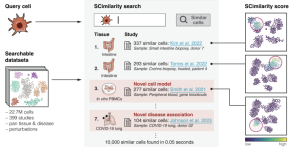Liquid biopsies and AI give insight into eye health and aging

At a Glance
- Researchers used a liquid biopsy technique to assess thousands of proteins in eye fluids and identify cellular drivers for disease and aging.
- The approach could also be applied to other organs that have associated fluids.
Many diseases are diagnosed via biopsy, in which a physician removes a small sample of cells or tissues from an organ to look for evidence of disease. But biopsies can cause irreversible harm to organs that don’t regenerate, like the eyes or brain. This has made it hard for researchers to study cell-level activities and gene functions of these organs in living people.
A research team led by Dr. Vinit Mahajan of Stanford Medicine hit on the idea of analyzing fluids within the eye that are often accessible and removed during eye surgery. The scientists suspected that these eye fluids might be enriched with a variety of cell-specific proteins that could serve as biomarkers to indicate health or disease.
The researchers obtained liquid biopsies from 120 people undergoing eye surgery. Some had conditions that can lead to vision loss. These included diabetic retinopathy, which damages blood vessels in the retina, and uveitis, which is inflammation inside the eye. Other liquid biopsies were from healthy people, including some who had cataracts but otherwise healthy eyes. Results were reported in Cell on October 26, 2023.
The researchers used an analytic technique called proteomic profiling to identify all the proteins present in the liquid samples. They detected nearly 6,000 unique proteins, a significant improvement over previous techniques. Using available mRNA sequencing data from different eye cells, the team then created algorithms that could trace the proteins back to the types of cells that made them. The eye contains 57 known types of cells, including nerve cells, blood cells, immune cells, and blood vessel cells. Each type can release proteins into the eye’s fluid-filled regions. The team also included data on 15 cell types from outside the eye, including spleen and liver cells.
The researchers found that liquid biopsies from patients with diabetic retinopathy had distinctive protein patterns that shifted as the disease progressed. The markers of disease included proteins that affect blood vessel growth and immune cells. The findings could point to new strategies for treating the condition.
The team also found evidence that liquid biopsies from the eye might provide early clues to Parkinson’s disease. The scientists identified nine proteins, mostly from retina nerve cells, that were significantly elevated among participants with Parkinson’s disease. Further study would be needed to confirm this link.
Using machine learning and artificial intelligence, the researchers created “molecular clocks” that can predict the actual age of the eye and detect signs of accelerated aging. The eyes of people with early-stage diabetic retinopathy appeared to be about 12 years older than the eyes of healthy people. The eyes of those with the late-stage condition seemed to be about 30 years older than healthy eyes. And the eyes of patients with uveitis seemed an extra 29 years old.
With further study, the researchers say, the liquid biopsy technique might be applied to other organs that have associated fluids. These include the brain via spinal fluid, kidney via urine, lungs via lung fluids, and joints via synovial fluid.
“What’s amazing about the eye is we can look inside and see diseases happening in real time,” Mahajan says. “Our primary focus was to connect those anatomical changes to what’s happening at the molecular level inside the eyes of our patients.”
—by Vicki Contie
Funding: NIH’s National Eye Institute (NEI) and National Institute of General Medical Sciences (NIGMS); Research to Prevent Blindness, Lundbeck Foundation, BrightFocus Foundation, and VitreoRetinal Surgery Foundation.







